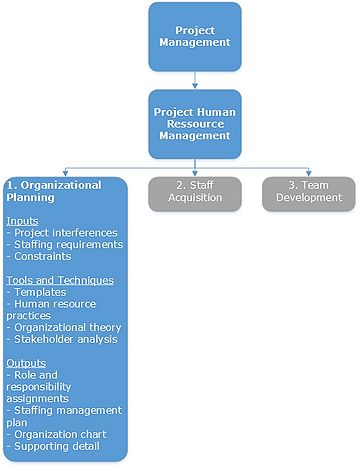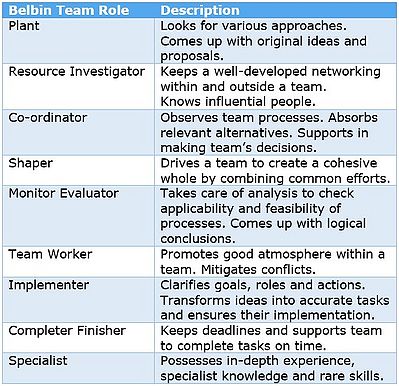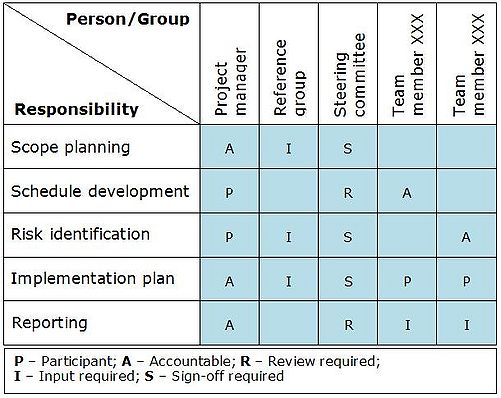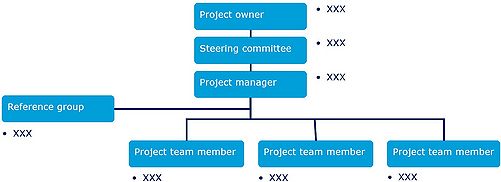Project Team Roles and Responsibilities
(→Background) |
(→Introduction to Project Human Resource Management) |
||
| Line 35: | Line 35: | ||
[[File:Project Human Resource Management.jpg|thumb|right|501x468px|Figure 1: Project human resource management overview, adapted from the PMBOK® Guide<ref>Page 94, 1996 ed. PMBOK® Guide</ref>]] | [[File:Project Human Resource Management.jpg|thumb|right|501x468px|Figure 1: Project human resource management overview, adapted from the PMBOK® Guide<ref>Page 94, 1996 ed. PMBOK® Guide</ref>]] | ||
| − | Project human resource management is one of the Project Management Knowledge Areas and includes a set of processes which ensures the most effective use of human resources throughout a project. According to Figure 1, which presents project human resource overview, there are three major processes within project human resource management, namely <ref>Page 93, 1996 ed. PMBOK® Guide</ref>: | + | Project human resource management is one of the project management knowledge areas <ref group="glossary"> '''The Project Management Knowledge Areas:''' A set of nine knowledge areas which contribute to project management knowledge and practice.<ref>Page 6, 1996 ed. PMBOK® Guide</ref></ref> and includes a set of processes which ensures the most effective use of human resources throughout a project. According to Figure 1, which presents project human resource overview, there are three major processes within project human resource management, namely <ref>Page 93, 1996 ed. PMBOK® Guide</ref>: |
* ''' Organizational Planning ''' - identifying, assessing and documenting roles and responsibilities as well as reporting relationships present in a project | * ''' Organizational Planning ''' - identifying, assessing and documenting roles and responsibilities as well as reporting relationships present in a project | ||
* ''' Staff Acquisition ''' - assigning the needed human resources to working on a project | * ''' Staff Acquisition ''' - assigning the needed human resources to working on a project | ||
Revision as of 08:43, 26 February 2018
Contents |
Abstract
Without a doubt the human role is an inseparable part of project management. Hiring and involving the right people who will be committed throughout a whole project life cycle [glossary 1] is of critical importance.[1] Thus organizational planning plays an important role within project human resource management [glossary 2] as its final output significantly effects project overall performance.[2] The output consists of, among others:
- Selection of a project team[glossary 3]
- Assignment of roles and responsibilities to everyone involved, which is a process of defining who does what (roles) and who decides what (responsibilities) and it is considered to be a solid foundation of every project to be successfully executed[3]
- Creation of an organizational chart
Project team roles and responsibilities should always link to a project scope, defined as "work required to output a project’s deliverable", [4] hence nothing is omitted as well as just value adding deliverables are performed. This is why it is essential to clearly allocate roles and define responsibilities for everyone within a project team already from the very beginning of a project life cycle.
This article focuses on the method of assigning roles and responsibilities to a project team members and applying adequate tools to ensure it is preserved and maintained properly during a project life cycle. The objective of the article is to provide project managers with instructions and application-ready templates. For superior understanding, methodology described in the article applies to a medium size projects and refers to the leading pharmaceutical industry best practices.
Motivation
It is project managers' role to build a project team, adequately assign roles and responsibilities to its members and make sure everything established is clear for everyone throughout a project life cycle. There are multiple reasons why project managers should have a careful approach to these processes.
First of all, it is essential to define a project size beforehand to support effective project execution. The more people are needed on board, the more roles and responsibilities need to be allocated among them. There are a certain roles which should be performed in medium and large projects but not necessarily in a small ones. This is also explained in detail further in the article.
Secondly, it happens that roles and responsibilities are assigned to people who do not have neither an interest nor a required knowledge or an experience to perform successfully. As a result, a project scope might become unsettled, deliverables might not be valueable as expected and in the end - a project might run behind a schedule.
Thirdly, transparency is a key for a project team to be effective. Once roles and responsibilities are assigned, project manager should ensure everything is documented as well as transparent and clear for everyone involved, otherwise there is a risk of not delivering what intended. Examples of tools and methods that support project managers in performing this processes are described further in the article.
Background
Before approaching a process of assigning roles and responsibilities to a project team, it is essential for a project manager to correctly define a project size. Taking under consideration the pharmaceutical company best practices, a project size is defined mostly based on the Total Project Cost (TPC) [glossary 4] and distributes as followed:
- Low-complexity projects (below 10 million DKK)
- Medium-complexity projects (more than 10 but less than 100 million DKK)
- Large-complexity projects (above 100 million DKK)
The article focuses on the medium-complexity projects to cover the steps that do not necessarily appear in the low-complexity projects but are relevant for project managers to be similar with.
Introduction to Project Human Resource Management

Project human resource management is one of the project management knowledge areas Cite error: Closing </ref> missing for <ref> tag</ref> and includes a set of processes which ensures the most effective use of human resources throughout a project. According to Figure 1, which presents project human resource overview, there are three major processes within project human resource management, namely [6]:
- Organizational Planning - identifying, assessing and documenting roles and responsibilities as well as reporting relationships present in a project
- Staff Acquisition - assigning the needed human resources to working on a project
- Team Development - developing of Project Team skills for team as a whole as well as for individual team members to increase level of project performance
The article focuses on organizational planning process, mostly on the usage of tools and techniques it contains, to generate successful output in terms of adequate assignment roles and responsibilities to a project team as well as transparent organizational chart.
Organizational Planning
Appropriate allocation of roles and responsibilities among a project team members and its transparency are crucial for successful project performance. That is why organizational planning process is done during the earliest phases of a project life cycle. Nevertheless, project managers should remember to review it regularly throughout a project, so it is ensured that just necessary roles and responsibilities are performed.
The main purpose for this process is to:
- Ensure a visible structure for overall roles and responisbilities
- Ensure clear roles and responsibilities
- Ensure fast reporting and decision making processes
- Secure sufficient resources for the project and the right competencies
It is important that a project organizational planning setup is documented, fully understood and agreed upon by all project team members to ensure clear roles and responsibilities.
Tools and Techniques Application
Once a project manager defined a project size and identified key roles and responsibilities, it is a time to form a project team out of the people who possess necessary competencies and experience. Project manager should preferably choose an internally available human resources from a parent company. Alternatively there is a possibility of hiring someone external, for instance from a consulting company, in case there is a need for a specialist who is not available in the parent company at that time.
In order to obtain desirable outcomes from a project organizational planning and thereby perform this process successfully, a project manager should respectively:
- Assign roles to a project team members - make sure to assign proper roles to proper people and ensure an organizational chart is created as an output
- Allocate responsibilities among a Project Team members - make sure to have Responsibility Assignment Matrix as an output
- Make sure the staffing management plan is regularly checked throughout a project life cycle
Assigning Project Team Roles and Responsibilities
Application: provide guidance on how to use the tool, concept or theory and when it is applicable
Based on Harvard Business Review, the right people need to be on board to meet project objectives. Moreover, these people need to have a clear understanding of what their roles and responsibilities are.[7]
Regarding to the pharmaceutical best practices within project management, a project organization consists of:[8] (note: make a table out of this with columns: Role, Responsibility)
- Project owner- Overall responsible for a project and anchoring in relevant governance structure
- Project manager- Responsible for driving a project in accordance with a project purpose, a project owner and other relevant stakeholders. Project manager makes sure that a project proceeds under the established budget, within the agreed time frame while being supported by sufficient resources and achieving its objectives.
- Steering committee (Project Governance)- Responsible for decision-making on key issues and overall guidance. Project managers should avoid having more participants than necessary – only these needed for taking critical decisions should be part of a steering committee. Stakeholders that can provide relevant input, but are not needed for a decision-making process, should be handled in a reference group or individually
- Reference group (optional but recommended to apply within medium- and large-complexity projects) - People from with the specific knowledge and area of expertise who are needed to provide the necessary input for the project
- Project team members- Individual who actively contribute in one or more phases in a project. Responsible for specific work streams within a project. Ensure that the work streams are structured in accordance with the key project deliverables and as far as possible can be managed independently of the other work streams
While comparing the particular pharmaceutical company best practices with ISO 21500, just a role of a project sponsor is not mentioned above. Nevertheless, it may be considered as a part of a steering committee. Project sponsor is responsible for authorizing the project, making executive decisions and solving conflicts which lie beyond a project manager's jurisdiction. [9]
When it comes to the medium- and large-complexity projects, where more people need to be involved, project team is proportionally more extensive as well as roles and responsibilities can be assigned and performed both by individuals or a smaller teams within a project team. In the low-complexity projects some roles, which are not relevant, can be omitted.

Belbin Team Roles (BTR)
Successful project team is not just a group of people with roles assigned based on their academic qualification, professional certification and competencies. The key point is to match the right individuals into designated project team roles. As the result, team spirit and motivation within a project team will be enhanced. It may occur not so easy, especially when project managers need to choose from a number of competent people who can perform multiple roles.
When project manager are in doubt of how to properly allocate roles to each project team members, they might consider using some theories or tools which support their final decision. One of the suggestions is application of the Belbin Team Roles (BTR) method. The method is in form of a personality test and based on its results it determines the suitability of project team individuals for specific roles within a project. [11]
According to the BTR method, there are nine roles in a team, namely: plant, resource investigator, co-ordinator, shaper, monitor evaluator, team worker, implementer, completer finisher, specialist. Each of them is briefly described in Figure 2. Based on the results from the personality test and description of the suggested roles, a project manager can get an overview and a process of roles assignment can be much easier.
Organizational Breakdown Structure (OBS)
Once project team roles are distributed, it is essential that a project manager makes sure it is transparent for everyone. An Organizational Breakdown Structure (OBS) is a good example of how to ensure a visible structure of the roles within a project team. The OBS is a specific type of an organization chart[glossary 5] which clearly presents assignment of roles and responsibilities to a project team individuals or units. [12] and an important output from the organizational planning process.
A creation of the OBS is a simple process once the project team roles are already known. It graphically presents a top-down structure of a project organization.
Figure 3 shows a template of a medium-complexity project's OBS which is being used by project managers from a specific pharmaceutical company based on its best practices. The blue fields present roles whereas each "XXX" on fields' side is dedicated for individual's names and their job positions. As a result, the chart includes all relevant information, hence person who sees it exactly knows who contact to if that would be a case. In more complex projects there might be more than just one person assigned to some roles, such as steering committee or reference group.
Additionally, as it can be seen on Figure 3, the OSB transparently shows correlations between roles in terms of their authority levels and reporting.
It is worth mentioning that in the low-complexity projects not all of the roles are relevant and need to be covered. For instance, it is common that reference group is necessary mostly in medium and large-complexity projects.
The OSB should be available for everyone and being constantly updating, since roles and people involved may vary over a project life cycle.[13]
Responsibility Assignment Matrix (RAM)

Once set of roles is defined and allocated between a project team members, it can be combined with responsibilities. A project manager role is to make sure it is clear what should be done by whom throughout a project life cycle.
Responsibility Assignment Matrix (RAM) is a popular tool, using by project managers, which visualizes assigned roles and responsibilities and as a result, makes it transparent for everyone involved. Another important purpose of using RAM is ensuring that project team roles and responsibilities are closely link to a project scope definition.[15]
To perform it well and appropriately, project managers can follow these steps:[16]
- Make sure necessary roles throughout project are defined and distributed within a project organization team.
- Identify all project deliverables.
- Discuss with project team members how they would like to support each other to enhance project performance. Define each team member's responsibilities.
- Prepare the initial RAM draft - place the responsibilities on the left-hand column and each individual/group in the top right-hand raw. Fill out formed matrix cells with an adequate type of responsibility (P-Participant; A-Accountable; R-Review required; I-Input required or S-sign-off required)
- Confirm with all project team members on created RAM draft to prevent misunderstandings.
- After everyone's approval is obtained - complete the final RAM.
It is important that project managers remember to update the RAM by going through the steps 3-6 once again if responsibilities change during a project life cycle.[17]
RAM is applicable to every project but its final layout depends on a project size. In lower-level projects roles and responsibilities are assigned individually to each of a project team members. Nevertheless, the more complex a project is the more people need to be involved. Thus, in medium and large-complexity projects roles and responsibilities may be assessed both to the individual units as well as groups of people.[18] In case of high level project complexity, it may be worth considering to divide responsibilities into sub-tasks and add a column with tasks' description to keep the RAM clear and easy to follow.
Figure 4 presents an example of RAM in a medium-complexity project. In the top right-hand raw it includes roles of individuals (e.g. project manager) but also groups of people (e.g. reference group). Empty fields mean that a particular role does not have any responsibility for a corresponding task. For instance, both team members do not have any responsibility for a scope planning, due to the fact that a project team is usually being selected after a project scope is already defined. Following this example, it is a project manager responsible for a scope planning, a reference group is required to provide a project manager with an input and finally steering committee is responsible for signing a scope plan once it is defined by a project manager.
Generally, the RAM is a good project management tool which lets project managers know whether a distribution of tasks is done correctly, keeps all project team members in loop and reduces miscommunication between them and as a result - enhances project performance.
Limitations
Limitations: critically reflect on the tool/concept/theory and its application context. What can it do, what can it not do? Under what circumstances should it be used, and when not? How does it compare to the “status quo” of the standards – is it part of it, or does it extent them? Discuss your article in the context of key readings / resources provided in class. Substantiate your claims with literature
Roles and responsibilities assignment is a very important output from the organizational planning process and has a solid influence on further level of a project performance. Every project needs to have its team roles and responsibilities defined and allocated at the earliest possible stage. Many activities contribute to obtain a desirable output. There are some tools and methods available to support project managers during this process, however limitations need to be considered before and during their application.
Before applying tools and methods, it is important for project managers to keep in mind that they are limited with two general points to ensure valuable assignment of roles and responsibilities.
Firs of all, project managers need to define a project size (low, medium or large complexity) beforehand. It is relevant since usage of methods and tools strongly depend on it.
Second of all, roles and responsibilities need to be strongly linked to a project scope, so it is ensured that nothing will be omitted as well as just necessary work will be performed.
Reflection on tools and methods used
- Belbin Team Roles (BTR), suggested in this article as a method for supporting project managers while assigning roles to a project team, has some points that need to be kept in mind. Firstly, the test does not have a personality results and thereby does not highlight the best matches when it comes to create a group of people within a project team, for example a reference group. Therefore, project managers should be careful when matching people with a similar competencies to share the same role, because they can simply not be pleasant and efficient while working together. Secondly, the nine Belbin team roles are not an exact equivalent of roles within a project organization. They may just give a suggestion to project managers of who would be a good choice to performing which role, but they should not completely rely on this results. Ideally, the final assignment could be a combination of BTR suggestions and project managers' personal opinion about a project team members.
- Organizational breakdown structure (OBS), known as an output from the organizational planning process, is a tool to present a project organization chart in a clear way. The only limitation is that once OBS is created, it is not fixed. Roles tend to change throughout a project life cycle and thereby the OBS needs to be constantly reviewed and updated by project managers to avoid ambiguity and misunderstandings.
- Responsibility Assignment Matrix (RAM), presented as a tool used by project managers to transparently present who within a project team is responsible for which tasks. Project managers need to keep in mind, that there is no fixed template for RAM - its layout strongly depends on a project size which needs to be defined beforehand for RAM to be valuable. Another point is that it does not provide a project team with responsibilities' flexibility once it is created, thereby it is important to keep a well-developed communication system within a project organization, hence RAM can be adjusted to a project and its team needs. Finally, as in case of OBS, RAM is not fixed once it is created, hence project managers need to remember about updating it constantly after even a minor change within roles and responsibilities was made.
Glossary
- ↑ Project Life Cycle: A time slot within a project phases are performed. In case of project management it has defined start and end dates.
- ↑ Project Human Resource Management: A set of processes within a project which ensure the most effective use of human resources.
- ↑ Project Team: A group of people created for a sole purpose of performing a certain project within its life cycle. The team is disbanded once a project is completed.
- ↑ Total Project Cost (TPC): A sum of Operational Expense (OPEX) and investment (CAPEX) including contingency sums.
- ↑ Organization chart:A diagram that shows the structure of an organization and the relationships of its parts and positions.
Annotated bibliography
Provide key references (3-10), where a reader can find additional information on the subject. The article MUST make appropriate references to the reference material provided in class – either incorporating it as a source, or critically discussing aspects that are missing from it but covered by this article. Summarize and outline the relevance of each reference to the topic (around 100 words per reference). The bibliography is not counted in the suggested 3000 word target length of the article.
Annotated bibliography: Does the article properly cite and acknowledge previous work (reference material provided, and appropriate other sources where necessary)? Does it briefly summarize the key references at the end of the article?
- Project Management Institute. "A Guide to the Project Management Body of Knowledge (PMBOK® guide)". 1996 Edition.
This book includes a relevant theory, concepts, and terminology within Project Management.
ISO 21500 (2013): Guidance on project management International Organisation for Standardization. This is the ISO standard for project management. It provides clear and authoritative definitions of ....
References
- ↑ https://www.pmi.org/learning/featured-topics/resource Project Management Institute. Retrieved 12 February 2018.
- ↑ Page 31, 1996 ed. PMBOK® Guide
- ↑ Page 96, 1996 ed. PMBOK® Guide
- ↑ https://www.pmi.org/learning/featured-topics/scope Project Management Institute. Retrieved 15 February 2018.
- ↑ Page 94, 1996 ed. PMBOK® Guide
- ↑ Page 93, 1996 ed. PMBOK® Guide
- ↑ https://hbr.org/2016/11/five-critical-roles-in-project-management Five Critical Roles in project management by Harvard Business Review Staff. Retrieved 13 February 2018.
- ↑ https://www.villanovau.com/resources/project-management/project-team-roles-and-responsibilities/#.WoriCbynHIU Project Team Roles and Responsibilities by Villanova University. Retrieved 19 February 2018.
- ↑ Pg. 51, 2013 ed. ISO 21500: Guidance on project management: Roles, responsibilities, tasks and activities.
- ↑ https://www.projectsmart.co.uk/belbin-and-successful-project-teams.php Article title: "Belbin and successful project teams" by Dr. Dirk Jungnickel and Abid Mustafa. 8 December 2012.
- ↑ https://www.projectsmart.co.uk/belbin-and-successful-project-teams.php Article title: "Belbin and successful project teams" by Dr. Dirk Jungnickel and Abid Mustafa. 8 December 2012.
- ↑ Page 98, 1996 ed. PMBOK® Guide
- ↑ Page 96, 1996 ed. PMBOK® Guide
- ↑ Page 96, 1996 ed. PMBOK® Guide
- ↑ Page 96, 1996 ed. PMBOK® Guide
- ↑ Mulder, P. (2012), "Responsibility Assignment Matrix (RAM)". Retrieved 24 February 2018
- ↑ Mulder, P. (2012), "Responsibility Assignment Matrix (RAM)". Retrieved 24 February 2018
- ↑ Page 96, 1996 ed. PMBOK® Guide
